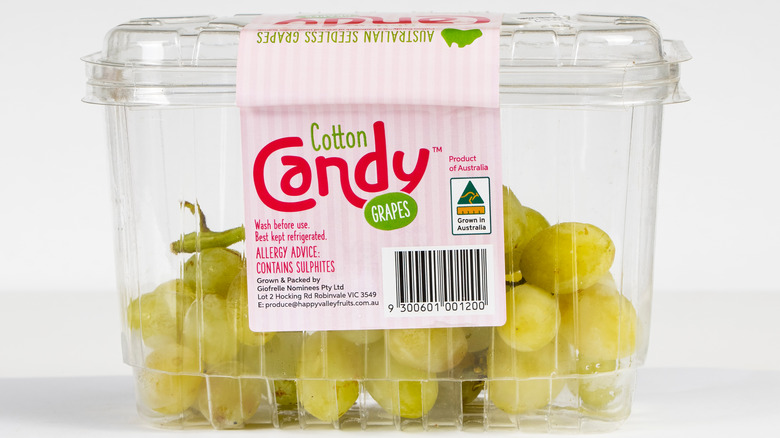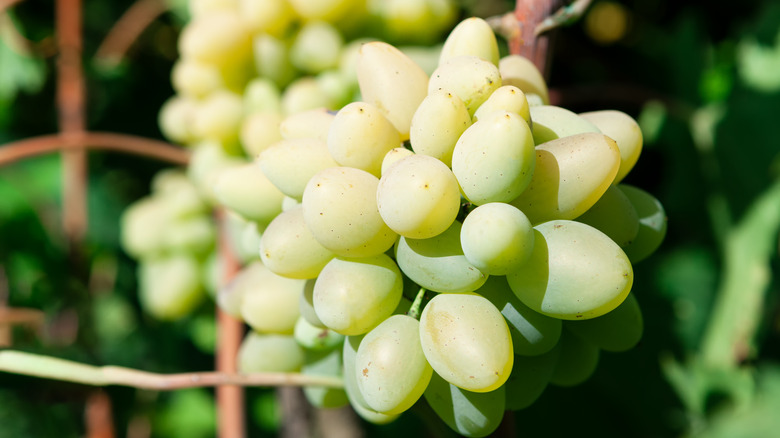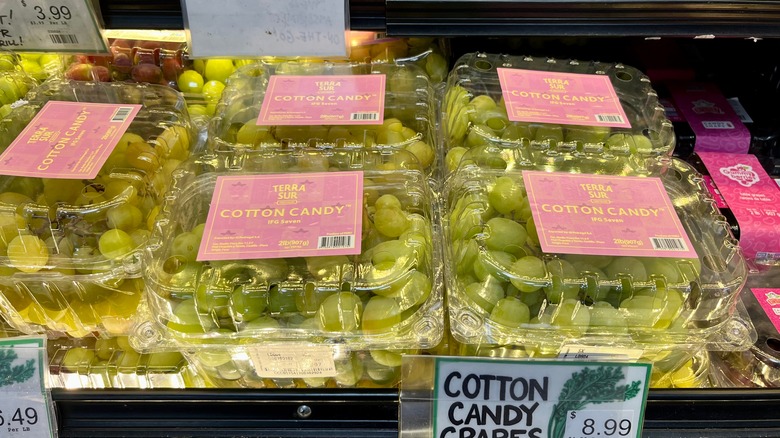Why Are Cotton Candy Grapes Are So Sweet?
Cotton candy grapes are the poster child of designer fruits, but they're part of a massive catalog of specialty fruit that includes the likes of Gum Drop grapes, Picasso melons, Pinkglow pineapples, Rosé strawberries, and many more. Outlandish as they may sound to some, such "artificial" fruit is primarily a result of plant breeding practices and not some other form of genetic modification.
The sweetness of cotton candy grapes comes entirely from the grape itself and is not the result of additives. The spun-sugar flavor is achieved by tweaking the acidity and flavor profile of existing grape species through clever crossbreeding. Doing this is no small feat and can take years of research, but the results are worth it — for consumers and producers. As Jim Beagle, the CEO of Grapery — the company that grows cotton candy grapes — told the NYT, customers are willing to pay twice as much for sweet fruits than the regular variety.
So, running the logic backward from grape-flavored confections, we arrived at confection-flavored grapes. But can fruit actually be modified to be this sweet and still retain its wholesome image? The story of cotton candy grapes gives us an interesting peek into where our everyday fruits may be headed. There is reason to be excited and surprisingly little to worry about (for now).
The natural sweetness is a result of years of research
A fruit that tastes so much like artificially flavored sugar confectionary seems suspicious. After all, the pink spun sugar namesake of cotton candy grapes is flavored using ethyl maltol — a common dessert ingredient that tastes like caramelized sugar, a compound called strawberry furanone for the fruity notes, and another that adds a hint of vanilla to tie everything together.
Getting a natural fruit to taste like a blend of these compounds is the result of good old plant breeding, which has been practiced for hundreds of years. Plants are regularly crossbred for better yield, hardiness, flavor, and other benefits. When fruit scientist Dr. David Cain came across a variety of Concord grapes that tasted like cotton candy but had seeds and lacked a snappy texture, he decided to refine them. 100,000 trial grape plants grown in test tubes later, the doctor finally had a plant that produced cotton candy grapes as we know them. As Cain told NPR, the process of coming up with a marketable designer fruit such as this can take anywhere between six and 15 years.
To get the grapes to taste like cotton candy, their sweetness must linger on the tongue longer. This was achieved by cutting down on the tartness of the fruit. However, adding that crucial hint of vanilla was more challenging and required Cain and his team to look to obscure grape varieties for genes to add to their new hybrid.
Are cotton candy grapes as healthy as regular grapes?
The good news is that since cotton candy grapes are hybrid plants, they contain natural sugar and all the other healthy fiber, vitamin C, and antioxidants you can normally expect from the fruit. The packaging also specifies they are non-GMO, though GMO foods are considered safe to consume by the FDA. However, it's important to note that 100 grams of cotton candy grapes contain about 18 grams of sugar, which is higher than most other grape varieties.
Ultimately, there is no catch behind the extra-deliciousness of cotton candy grapes except for the marginally higher sugar content. Commercial fruit was crossbred for higher yields and better hardiness for decades, with flavor taking a back seat. Companies like Grapery are shifting the focus back to palatability, which is why a cotton candy grape vine can take up to three years to bear fruit, and some other varieties can take over a decade to cultivate.
However, as the market (and our tastebuds) can attest, the additional time to grow and, as a result, the higher cost of these fruits is well worth it. During their short-lived growing season between August and September, the popularity of these sweet treats can sometimes make them difficult to get your hands on. If Cain's team could give us a grape that lasts a little longer in the season, some kids might not even protest at getting a bag of them as Halloween candy. But, maybe that's wishful thinking.


